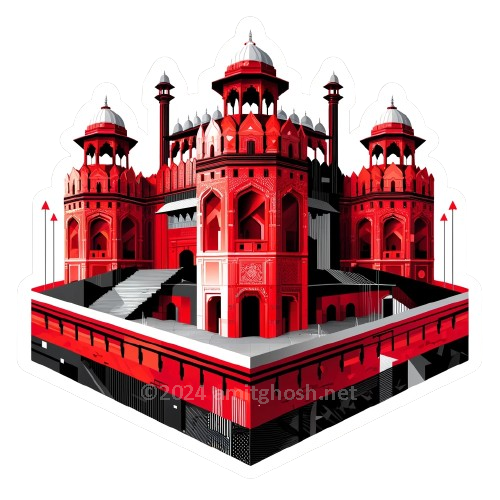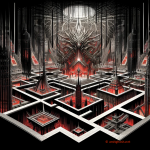9th April, 1719 …
The air in Delhi was thick with tension, the kind that precedes storms of change. A woman, draped in a burkha hidden in the shadows of an alleyway near the imperial palace, felt the weight of his rapid breaths. The dusk cloaked the city in a deceptive calm, but the night was anything but peaceful.
She knocked firmly on the hefty iron door. A silhouette appeared, a woman holding an oil lamp with a bright flame encased in glass. heir nods bridged words unspoken, and then they quietly slip through the door.
Conspiracy
Six years ago …
Whispers of conspiracy had wound their way through the city like a serpent, speaking of Farrukhsiyar’s ambitions and his ruthless resolve to claim the Mughal throne. Shah Alam had heard rumors, but nothing could have prepared him for the sight he was about to witness.
As the first light of dawn broke, a contingent of Farrukhsiyar’s soldiers stormed into his brother Zulfiqar’s residence. Zulfiqar, a man of intellect and military prowess, had sensed the looming threat but chose to face it head-on, surrounded by his family and a few loyal guards.
Sheltered by the haystacks adjacent to the cowshed, Shah Alam observed as the doors succumbed to the invaders’ force. The clash of iron rang out, a harrowing overture to the tragedy unfolding within. He saw through the open windows as if in slow motion, the valiant but futile resistance offered by Zulfiqar’s guards.
Farrukhsiyar’s men were ruthless, their blades not discriminating between the warrior and the innocent. Zulfiqar Khan fought with the ferocity of a cornered tiger, but even tigers fall when outnumbered. Shah Alam’s heart raced as he saw his brother momentarily lock eyes with him, an unspeakable farewell passing between them.
Then, chaos. The soldiers descended upon Zulfiqar Khan, their blades a blur. Beside him, his wife tried to shield their children, her eyes wide with terror. The scene was a maelstrom of desperation and defiance, the air rent with the sounds of combat and the cries of the fallen.
In the middle of turmoil, as the battle cries echoed through the dawn, a chilling silence descended when Farrukhsiyar himself, with a demeanor as cold as the steel of his sword, stepped into the fray. He turned his cold gaze upon Asad Khan, the venerable patriarch of the fallen. The conqueror’s eyes, devoid of mercy, fixed upon the defeated nobleman.
Despite the chains of age, Asad Khan stood with an indomitable spirit, his once robust frame now withered to frailty, yet his eyes blazed with an undiminished fire. Even in captivity, he had dispatched several of Farrukhsiyar’s soldiers, a testament to the enduring might of his lineage. Nearby, Zulfiqar Khan lay defeated, his body a canvas of wounds from which his life’s essence ebbed away.
With a calculated calm that belied the brutality of his actions, Farrukhsiyar addressed the aged warrior. “Asad Khan,” he said, voice steady, “you have one final choice. End your son’s suffering with your own hands, and I shall grant you mercy in your final days. Choose defiance, and you shall watch as your name and blood are dragged through the dirt of Delhi.”
The air trembled with the weight of his words, a cruel bargain laid at the feet of a father already burdened with loss. Asad Khan, embodying the dignity of his ancestors, met Farrukhsiyar’s demand with the fierce resolve that had defined his life. With a defiant smile, Asad Khan gathered his spit and launched it at Farrukhsiyar, the spit, mingled with blood, striking Farrukhsiyar’s face and leaving a stark, crimson mark—a bold symbol of defiance against tyranny.
Farrukhsiyar signaled to his men. One soldier, with grim resolve, dragged Zulfiqar upright in front of his father. Farrukhsiyar then unsheathed his sword, its blade gleaming with a sinister light. “Witness the consequence” he announced, as he approached Zulfiqar. The air hung heavy with dread as Farrukhsiyar, with swift and cruel precision, blinded Zulfiqar with two strokes of his blade. Asad’s anguished cries pierced the solemn air, a dire echo of the darkness that had now seized him.
As the echoes of Asad’s cries faded, a sinister smile crept across Farrukhsiyar’s face, his cold amusement chilling the air as Asad Khan’s defiant voice rose in response, a testament to a spirit unbroken even in the face of unspeakable cruelty.
Farrukhsiyar, his face twisted in a sneer of contempt, signaled his soldiers with a flick of his wrist. “Let the streets of Delhi bear witness to the cost of defiance,” he decreed.
Farrukhsiyar, his face twisted in disdain, signaled his soldiers. “Parade them through the city on elephants, all the way to the Delhi Gate,” he commanded with a stern voice that brooked no argument. “Make a spectacle of them for all to see. Let it be known this is the fate of those who oppose me.”
The soldiers, understanding their orders, moved quickly to execute the command. They dragged the battered bodies of Asad Khan and Zulfiqar Khan, preparing them for the grim parade through the city, towards the elephants that awaited to carry them through the streets to the Delhi Gate.
When silence finally reclaimed the space, it was a silence of absence. The floor was painted in the grim palette of loss. Zulfiqar’s wife and his children lay motionless, their blood seeping into the fabric of history. Farrukhsiyar’s soldiers looted what they could, leaving behind a scene of stark finality.
Shah Alam, heart shattered, retreated into the shadows. The dawn had witnessed a massacre, a brutal punctuation to the sentence of his brother’s life and reign. This was not just the death of his family but the death of an era. Shah Alam fled Delhi, the images of that dawn seared into his memory, a haunting reminder of the cost of power and the fragility of life in the Mughal Empire’s twilight years.
Ascension
Zulfiqar Khan’s lineage was noble, descending from a family with deep roots in the Mughal Empire’s military and political spheres. His father, Asad Khan, was the esteemed wazir to Emperor Aurangzeb, marking Zulfiqar as a man destined for greatness, a bearer of his family’s legacy. Zulfiqar’s reputation as a military strategist and a statesman of unparalleled acumen preceded him, his life a testament to the empire’s glory days.
In 1707, as the mighty Emperor Aurangzeb passed away, his empire, a vast realm of wealth and power, was thrown into chaos. His sons, driven by a thirst for power, plunged into a fierce battle to take his place. Zulfiqar Khan and his father Asad Khan, found themselves amid this storm. They aligned with Prince Azam Shah, one of the contenders for the throne.
The battlefield was set at Jajau, where Azam Shah’s forces met with those of his brother, Prince Bahadur Shah. Seeing the tide of battle turn against them, Zulfiqar advised Azam to retreat, to save their strength for another day. But Azam, burning with the desire to win, pushed forward. The battle was brutal, and in the chaos, Zulfiqar, with a heavy heart, chose to flee to Gwalior, narrowly escaping with only minor injuries. Azam wasn’t so fortunate and met his end on the battlefield.
Despite his initial choice to side with Azam, Zulfiqar was summoned back to the heart of the empire by the new ruler, Bahadur Shah. In a surprising turn of events, he was not only forgiven but elevated in rank. There was a rumor that He secretly supported Bahadur Shah and intentionally fled with most of the force during the battle.
He was reappointed as the empire’s chief military officer and later, was given the prestigious role of governing the Deccan region.
As Bahadur Shah’s health waned and he lay on his deathbed, the Mughal Empire stood on the verge of a crisis, the air heavy with the anticipation of a looming battle for succession. The stage was set for a clash of wills among his sons, each vying to inherit the throne of their illustrious father. The most formidable among them was Azim-us-Shan, a prince of vast influence and wealth, having amassed his fortune and power as the governor of Bengal. His presence loomed large at the court, casting long shadows over his competitors.
In contrast, the other contenders, Jahan Shah, Rafi-us-Shan, and the least formidable, Jahandar Shah, seemed to pale in comparison. Yet, it was in this intricate web of ambition and rivalry that Zulfiqar Khan, the empire’s most powerful noble, stepped in with a plan that would forever alter the course of Mughal history.
With a blend of cunning and political savvy that would have made the most seasoned statesman envious, Zulfiqar Khan maneuvered through the treacherous waters of court intrigue. He forged a clandestine alliance between the three underdog princes, creating a united front against Azim-us-Shan.
Through diplomatic mastery and strategic brilliance, Zulfiqar Khan orchestrated Azim-us-Shan’s defeat, paving the way for Jahandar Shah’s rise to power. But his machinations did not stop there; he then supported Jahandar Shah in a ruthless consolidation of power by killing the other two princes. Zulfiqar didn’t just elevate Jahandar Shah to the throne; he bound the new emperor to him, making his rule entirely dependent on his support.
He became the “The First Kingmaker of the Mughals”.
Through his actions, Zulfiqar Khan demonstrated that true power often lies not in the hands of those who wear the crown, but in those who have the vision and the will to place it upon the head.
Zulfiqar Khan, wielding the reins of power with a deft hand, embarked on a mission to mend the frayed edges of the Mughal Empire, reaching out to the Rajputs, Sikhs, and Marathas. These groups, once integral to the empire’s vast mosaic, had grown distant, their alliances frayed by years of neglect and discord. Zulfiqar, in a bid to weave these threads back into the empire’s fabric, made a bold move: he abolished the jizya, a tax that had long burdened non-Muslim subjects, signaling a new era of tolerance and inclusivity.
His overtures of peace and unity did not stop there. In a gesture of reconciliation and respect, he bestowed high-ranking positions upon Rajput leaders Jai Singh II and Ajit Singh, integrating their strength and valor into the empire’s leadership. This was a masterstroke, aimed at solidifying a fragile peace and fostering a sense of belonging among the empire’s diverse subjects.
However, the tranquility of Jahandar Shah’s reign, under Zulfiqar’s careful administration, was not to last. The shadows of discontent and rebellion loomed large as Farrukhsiyar, a scion of the deceased prince Azim-us-Shan, raised the banner of revolt. Bolstered by the formidable Sayyid brothers, Farrukhsiyar tapped into the simmering unrest and dissatisfaction within the empire. The storm of rebellion he unleashed was a test of fire for Jahandar Shah’s rule.
Faced with an underpaid and disorganized army, a reflection of the empire’s internal turmoil, Jahandar Shah was unable to withstand the tide of Farrukhsiyar’s advance. The decisive confrontation near Agra was a resounding defeat for the emperor, crumbling the last pillars of his dominion. In a poignant turn of fate, Jahandar Shah found himself a fugitive in his land, seeking sanctuary in the home of Asad Khan, Zulfiqar’s father and a former wazir.
Camouflage
The distinct call of a peacock pierced the air.
On a fateful day, Shah Alam, Zulfiqar’s brother, arrived from Bengal at his father Asad Khan’s house with urgent news concerning English tradesmen—a matter of grave importance that hinted at the shifting tides of power and commerce. As the sound of horse hooves approached, a tense anticipation filled the air. Zulfiqar, ever vigilant, sensed the impending danger. With a swift decision, he ushered Shah Alam and his niece into the relative safety of a haystack near the cowshed, a humble hiding place that belied the nobility of their blood.
In the dim light of dawn, Shah Alam’s heart pounded against his chest, a frantic drumbeat signaling his urge to leap into the fray, to confront the assassins head-on. But Zulfiqar, through the narrow gaps of their rustic concealment, met his brother’s gaze. In his eyes, Shah Alam read a silent command, a plea underscored by the presence of his daughter. It was a look that spoke volumes, a desperate bid for the continuation of their bloodline, for the safety of the innocents among them.
Under the vast expanse of the early morning sky, Shah Alam stood alone, the devastation behind him a stark reminder of the price of power and betrayal. He lifted his gaze upward, where the first rays of sunlight pierced through the darkness, painting the heavens with hues of gold and crimson.
With clenched fists and a heart heavy with the promise of vengeance, he whispered a vow into the chill of the dawn air, “To the heavens that bear witness to this injustice, hear me now. The cruelty Farrukhsiyar has bestowed upon my brother, upon my flesh and blood, will not go unanswered. A day will come, Farrukhsiyar, when the shadows you’ve cast will engulf you. I swear, with all the fury and grief that now consumes me, I will return to mete out justice as you have done, but with a precision and a wrath you cannot fathom. You took the light from my brother’s eyes; so too shall I extinguish the light from yours, an eye for an eye, in the exact measure of your cruelty.”
His vow hung in the air, a promise etched into the fabric of time, as Shah Alam’s silhouette blended into the tapestry of fleeing shadows. The horizon blazed with the light of a new day, but for him, it marked the beginning of a quest for retribution, a path that would lead him through the corridors of power and into the annals of history. The empire, still slumbering in the innocence of dawn, remained unaware of the storm that was to come, a storm born from the ashes of betrayal and fueled by the unyielding spirit of a brother wronged.
Vengeance
In the years shadowed by the past’s sorrow, Shah Alam sought solace in Katwa, a quaint town nestled on the western banks of Bengal, cradled by the confluence of the Ganga and Ajay rivers. Katwa, with its strategic position at the crossroads of vital waterways, had long been a place of significance. The town thrived under the imperial decree that granted English tradesmen the right to conduct their business tax-free, a testament to the emperor’s favor towards foreign commerce. However, this gesture of goodwill towards the English did not sit well with the local Nawab. His discontent with the emperor’s policies created an environment of indifference towards the emperor’s adversaries, making Bengal a haven for dissenters and rebels alike.
In this atmosphere of political apathy and strategic advantage, Shah Alam found the perfect cover for his dual existence. While outwardly embodying the ascetic life of a Sufi, inwardly he was anything but passive. Bengal’s indifference to the emperor’s enemies provided him with the anonymity needed to plot his revenge, its bustling markets and thriving port a façade behind which he could gather his forces, unnoticed by those who would seek to thwart his plans.
Before visiting his father Asad, on the day of tragedy, Shah Alam had arrived with a strong group of 200 soldiers. They were stationed near Beharampur as a guest of Nawab of Murshidabad. He left with only 10 of his bravest men, and they were lost in a terrible fight on that fateful night.
Shah Alam did not give up. He gathered his remaining soldiers and built a special mosque near the Ganga River in Katwa. But this was no ordinary mosque; it looked more like a fortress and had deep tunnels on three sides, with one side open to land. These tunnels connected to a secret passage that led to the river, hidden deep underground. To the untrained eye, he was but a Sufi saint, embracing a life of spiritual contemplation and peace. Yet beneath this cloak of tranquility, Shah Alam harbored a fervent desire for vengeance, silently forging an army from those who shared his yearning for justice.
Shah Alam created a small community around this mosque fortress. To avoid drawing attention, everyone had a disguise. Some became to be tea sellers, while others became cotton merchants. This clever disguise allowed them to blend in with the locals and go about their business without anyone suspecting their true purpose.
After some time, Shah Alam began sending out some of his men disguised as cotton merchants to Delhi. Their mission was to gather secret information that could help Shah Alam in his plans. These disguised soldiers became his eyes and ears, collecting valuable details without being noticed.
One day, during a quiet meeting in the shadowed corners of the mosque, Shah Alam spoke with one of his closest allies, who had just returned from Delhi.
“We’ve received word, my lord,” the ally began, his voice low and urgent. “The emperor has discovered our location. He’s sending soldiers to investigate Shahi Masjid.”
Shah Alam’s response was calm, yet filled with resolute strength. “Let them come,” he said, a spark of determination in his eyes. “We are prepared.”

The distinct call of a peacock pierced the air, a sound Shah Alam knew all too well. It was a signal he had taught his soldiers to use, a method of communication crafted from the mimicry of bird calls!
One evening, as the golden hues of sunset embraced the Shahi Maszid, a group of Farrukhsiyar’s soldiers arrived unannounced. Their presence, meant to intimidate, only served as a reminder of the unresolved past.
“Allah hu Akbar,” a soldier called out, his eyes scanning the serene compound with a mix of curiosity and skepticism.
“Shah Alam, we’ve heard of your spiritual endeavors,” the leader, a stern man with the bearing of authority, declared as they stood in the mosque’s expansive courtyard. “The Emperor appreciates your dedication to peace. He sees it as a sign of your submission.”
With a serene smile, Shah Alam faced them, his voice steady, “Tell your Emperor, I am but a humble servant of the divine. The politics of thrones and power never concerned me.”
The soldiers, satisfied or perhaps choosing to believe the facade presented, departed as swiftly as they came, their boots echoing off the stone. As the soldiers departed, the air seemed to thicken with unspoken words and unseen tensions.
Shah Alam turned his gaze back to the horizon.
Yet, as night fell over the river of the Ganga, a shadow lingered.
One soldier, curiosity or perhaps a sense of unfinished duty anchoring him, stayed behind, concealed within the darker recesses of the masjid.
Intrigue
It was not any ordinary soldier who chose to stay hidden within the dark confines of the Shahi Masjid. It was Ajit Singh Rathore of Marwar, a name whispered with reverence and fear across the lands that once bowed to his ancestors.
As he stepped forward from the shadows, his gaze fixated on the tranquil figure of Shah Alam, his mind was a tempest of memories and vendettas, a tapestry of Marwar’s tumultuous history woven with the threads of defiance and survival.
The story of Ajit Singh was not just his own but a chronicle of Marwar’s relentless struggle against the imperial might of the Mughals. His grandfather, Jaswant Singh of Marwar, a lion of the desert, breathed his last at Jamrud in December 1678, leaving behind a legacy cast in the shadow of uncertainty. With Jaswant Singh’s demise and no male heir to claim the throne immediately, Aurangzeb, the emperor with an iron fist, saw an opportunity to extend his dominion, converting the lands of Marwar into territories of the Mughal empire.
A nephew of Jaswant Singh was anointed as a puppet sovereign, a marionette dancing on the strings of Mughal ambition. Yet, the winds of dissent began to howl through the corridors of power as fate unfurled its own narrative.
The royal bloodline, however, was not to be so easily erased.
As the saga of the late Jaswant Singh’s lineage unfolded, his two queens, vessels of Marwar’s hope, each delivered into the world a son after his death. In those hallowed halls, where whispers of rebellion already stirred the air, the birth of these heirs ignited a flame of defiance.
Durgadas Rathore, the minister of Jaswant Singh, ignited the flames of resistance, challenging the decree of the emperor. He led a daring delegation to Shahjahanabad, pleading for the recognition of Ajit Singh, the eldest of Jaswant Singh’s posthumous sons, as the rightful ruler of Marwar.
Aurangzeb declined, proposing instead to elevate Ajit and grant him the title of raja, accompanied by a suitable noble status, upon reaching adulthood. This proposal, however, hinged on Ajit being raised in the Muslim faith, a condition that was completely unacceptable to those who had made the request.
Aurangzeb’s refusal to reinstate the young prince to his ancestral throne only fueled the fire of rebellion. The dispute took a darker turn with the death of Ajit Singh’s younger brother, tightening the noose around the legacy of Marwar. In a desperate bid for freedom, Durgadas Rathore orchestrated a daring escape from the clutches of the Mughal forces to the city of Jodhpur, smuggling Ajit Singh and the queens out of Shahjahanabad.
Amidst this chaos, a tale of sacrifice marked the beginning of Ajit Singh’s journey to reclaim his throne. The Dhaa Maa (wet nurse) of the infant prince, in an act of unmatched devotion, swapped her own son for Ajit Singh, ensuring the prince’s safety in a basket, smuggled out under the cover of darkness. Aurangzeb fell to this trick and sent the child to be raised as a Muslim in his harem (royal household).
Back then, it was common for soldiers to lose their lives in the forest. They fell victim to wild animals, illnesses, or bandits. Life was considered much less valuable in those days. Earlier in the forest, he had taken down one of the soldiers, taken his uniform, and blended in with the troops to get close to Shah Alam. He doubted whether Shah Alam would trust him after so much time had passed.
Now, as Ajit Singh Rathore stepped forward, the weight of his heritage heavy on his shoulders, he was not just a soldier in the shadows. He was the embodiment of Marwar’s indomitable spirit, a prince whose life was shaped by the struggles of his forebears.
His gaze was fixed on Shah Alam.
In the hushed ambiance of the mosque, Ajit’s voice softly broke the silence, “Hi, my friend,” his whisper reverberated off the ancient walls, carrying the weight of history and the warmth of old camaraderie. Ajit Singh, a close ally of his brother, stood in the dim light, his presence a testament to alliances forged in times both prosperous and perilous.
“Assalamu Alaikum,” came a voice unexpectedly from the shadows, rich with the resonance of authority and surprise. Shah Alam, true to his reputation, emerged like a phantom from the darkness, revealing the figure Ajit had initially mistaken for Shah Alam to be but a loyal soldier. The mosque, steeped in the echoes of whispered greetings, became a witness to the reunion of two souls intertwined by destiny and shared struggles.
“We have so much to discuss,” Ajit stated, his voice carrying a mix of hope and urgency.
It felt like his words were paving the way for deep and necessary dialogues—plans to be made, secrets to exchange, and strategies to formulate for what lay ahead.
Shah Alam, sensing both the significance of the moment and the weariness that enveloped Ajit, replied with a welcoming warmth.
“You must be tired. Let’s talk over while we eat something,” he offered.

Retribution
Now …
9th April, 1719
As dawn broke over the Red Fort, the air was thick with the scent of gunpowder and the echo of a night-long battle that had raged under the cover of darkness. The mighty fortress, a symbol of the Mughal empire’s unrivaled power, had become the stage for a dramatic turn of fate. Ajit Singh Rathore, alongside the Sayyid brothers, had led a siege that would mark the end of Farrukhsiyar’s reign. Amidst the chaos, a strategic alliance had been forged, one that united former foes against a common enemy.
Initially, the Sayyid brothers played a key role in installing Farrukhsiyar on the throne. Indeed, they were the ones who orchestrated the assassinations of Bahadur Shah and Jahandar Shah. They infiltrated Asad’s House through a cook when Jahandar sought refuge there and fatally poisoned his food. They always preferred to avoid chaos and bloodshed. These very brothers have now shifted their focus towards Farrukhsiyar. This move underscores the dangerous dynamics inherent in the struggle for power.
The palace grounds, scarred by the violence of the siege, bore witness to the final act of this power struggle. Ajit Singh’s men navigated the labyrinthine corridors of the fort, their mission clear. It was in these hallowed halls that they found Rafi ud-Darajat, the youngest prince, his fate about to be irrevocably changed.
But the coup de grâce was yet to come. Farrukhsiyar, the once mighty emperor, was found cowering in the sanctuary of his harem, surrounded by his mother, wives, and daughters. The irony of his hiding place, a domain ruled by the women he considered his protectors, would soon become the stage for his downfall. As the soldiers closed in, a tense silence fell over the room, a prelude to the impending retribution.
It was then that the unexpected happened. The distinct call of a peacock pierced the air. Farrukhsiyar’s opportunities to escape had been sealed off.
Amidst the harem’s veiled shadows, a figure stepped forward, her movements deliberate and unwavering. With the precision of one who had known betrayal and the taste of revenge, she wielded the needle that would seal Farrukhsiyar’s fate. The needle plunged into the emperor’s eyes, not by the hand of his captors, but by a woman from within his sanctuary.
The revelation sent a ripple of shock through the ranks. The woman was none other than Shah Alam disguised in the intricate garb of the harem’s inhabitants. This audacious plan, concocted with meticulous precision, had allowed Shah Alam’s forces to blend seamlessly with the palace workers, infiltrating the fort’s defenses from within. It was a maneuver that underscored the depth of Shah Alam’s resolve and his mastery over the art of war and deception.
In the charged silence of the chamber, four soldiers lunged toward Shah Alam with deadly intent. But in a flash, two figures—a whirlwind of grace and ferocity—stepped into their path. One, Shah Alam’s own progeny, a princess whose hands, though accustomed to the gentle grip of a rose, now wielded a dagger with the expertise of a seasoned warrior. Her companion in this dance of death was no less formidable: the captive daughter of Ajit Singh, a princess in her own right, her training with the blade evident in the fluidity of her movements.
In moments that seemed to stretch and bend, the clash of iron sang a deadly tune. Before the soldiers could lay a finger on Shah Alam, they were met with a swift and silent end, their threats extinguished by the princesses’ deft hands. The air was punctured by the heavy fall of bodies, a testament to the prowess of royal blood trained for battle.
Suddenly, a loud bang against the iron doors shattered the silence, signaling the onset of turmoil. Shah Alam, sensing the impending danger, raised his voice with authority, “Stay back!” His command resonated like thunder through the tension-filled room.
Then, with a noise that seemed to shake the very foundations of the room, a tide of soldiers, accompanied by the splintered remnants of what was once a door, cascaded into the chamber.
From this maelstrom of destruction stepped a figure both formidable and weary—Ajit Singh. Bloodied, limping, yet unbowed, his presence commanded the space. Upon sighting his daughter, a fierce joy cut through the grimace of pain. With a strength born of sheer will, he surged forward, his arms outstretched not for the sword, but to embrace his child, a poignant symbol of resilience and undying love amidst the ruins of battle.
“He is all yours,” Shah Alam’s voice thundered, a tumultuous blend of vengeance fulfilled and the liberation of a burden long carried.
His declaration, aimed at Ajit Singh, pierced the heavy air with the finality of a judge’s gavel. Within that moment, Farrukhsiyar, once an emperor draped in the majesty of power, became nothing more than a blind, broken figure, bereft of his imperial sight and dignity in a swift, brutal stroke of justice. Desperate, futile resistance marked his actions as he was seized by relentless hands, his body contorting in a vain attempt to escape the inexorable grip of his captors. They dragged him, a once-mighty ruler reduced to a pitiable state, towards a destiny he had always arrogantly believed was meant for his enemies, not for him.
The small room within the ancient Tripoliya Gate loomed as a silent witness to the culmination of this grim procession, its walls echoing the unspoken horrors of past retributions.
This somber chamber shrouded in the whispers of those who had met their grim fates within its confines, awaited Farrukhsiyar. It promised an end as merciless as the betrayal that had led him here—an end where his screams and pleas would find no audience save for the indifferent stones that had absorbed the cries of countless before him.
In the shadowed recesses of Tripoliya Gate, the cries of the old Mughal officials, begging for a mercy that would not come, echoed hollowly against the cold stone. Their voices, once powerful and commanding, now reduced to the whimpering of the powerless, seemed insignificant to Shah Alam. His vendetta, born from the deepest wells of grief and rage, had reached its conclusion, a poetic justice written in the blood of empires.
As the emperor’s painful end was happening, Shah Alam watched from a distance. He likes to control the light while staying in the dark. With solemn gravity, Ajit Singh and the Sayyid brothers presented the young prince to the peacock throne, anointing him the successor in a moment that was as symbolic as it was decisive.
Shah Alam quietly disappeared back into the shadows, fading away as if he were just a part of the night itself. He has the blood of a wazir flowing in his veins. He deliberately selected the feeblest among them to ascend the throne, knowing full well that the weakest links are effortlessly dominated and make the most pliable rulers.
He isn’t just a piece on the board; he’s the chess master controlling the game.
Sovereigns fall, yet from the ashes, hope gleams,
Heirs to Thrones, led by the last wazir’s dreams.
Amidst despair, his wisdom lights the way,
Heroes’ blood, in silent valor, they pay.
Against the dusk, his legacy unfurled,
Legacy of valor in a fleeting world.
A beacon bright, in darkest times, he stands,
Majestic force, fate resting in his hands.
















Leave a Reply